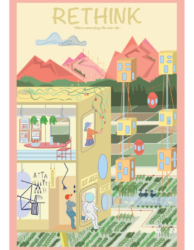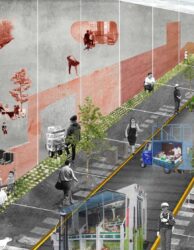
Resilient Pandemic Society
Rania Lfarakh
18/10/2020
Resilient Pandemic Society
The 21st century has been characterized by numerous incidents, from economic crises, urbanization, climate change to pandemics. With the outbreak of the coronavirus the cities are now in an emergency context, being endangered and under threats of those urban vulnerabilities. It is now, the time to think of a way to tackle those urgent challenges.
When an epidemic outstroke, it is usually the role of the healthcare system to tackle the issue, however, given that those epidemics have no effective vaccines, like the current situation of the COVID 19, one can only rely on self-isolation and lockdown to avoid the spreading process. thus, our built environment plays as an emergency response tool for the resilience of our society. Similarly, in 2006, When an epidemic of extensively drug-resistant tuberculosis emerged in Tugela Ferry, South Africa, it was a building that deserved some of the blame. Since the poor ventilation of the hospital led to the transference of the disease by air to the overcrowded patients in waiting areas. Therefore, poor spatial design was considered as one of the reasons for the epidemic spread. Moreover, when we look at previous pandemics, we can conclude that most of the disease transmissions were due to poor aeration, material types, and physical contact. Hence, if spaces are cautiously designed, allowing ventilation and choosing the right materials to decrease the transmission process. Then, architecture can contribute to the healing process of a city and its citizens. Additionally, As the Coronavirus has expanded, the urgencies of speed in creating more healthcare spaces were the most pressing need in the harsh situation of our present day. Taken the example of the city of Wuhan in China, the architects, and responsible planners have built a hospital in only two weeks by relying on using the modular construction principles, which are a prefabricated component that can be assembled in a site within days, it is also a safer and economically efficient option since there is less labor cost in the construction site. In addition to that, the components can be an asset to enlarge or reduce new spaces flexibly according to the building needs. Consequently, this modular strategy showed a flexible, fast, and resilient method that could adapt to the city’s constant change. In other words, the necessity of adapting and creating flexibility into space should be a priority in an outbreak design. Likewise, the COVID 19 outcomes have shown us the importance of urban resilience, where workers in healthcare, food production, or bus drivers, should have access to affordable housing near their working places, in order to avoid unnecessary transportation and reduce the possibility of infection. Since, society is part of a complex urban system, each vulnerability of citizens impacts the cities greatly, if today was an epidemic outbreak, tomorrow might be a climate change impact. Thus, there is an urge to rethink about redesigning our urban planning and opt for a mixed-used space’s design like it has been done in Vancouver and Singapore city’s plan. Besides, urban planners and architects shouldn’t forget about the sustainable aspect of the built environment design, due to its crucial importance in a society’s resilience, it not only enables the citizens to maintain stable mental and physical health, but it also reduces the noise pollution, improves and cleanse air quality, augments biodiversity, provides food in case there are planted roof gardens, and finally, mitigates climate change issues like flooding.
To sum up, despite the negative impacts of the current pandemic challenges, it also allowed us to see how a society could be resilient and adapt to critical challenges like it has been stated by Rahm Emanuel, President Obama’s chief of staff “You never want a serious crisis to go to waste. It provides the opportunity to do things that were not possible to do before.” We can conclude from that, although epidemics are seen as a tragic moment in our history, it is also a window of opportunity to rethink and implement a long-term planning strategy for our future and give priorities to strengthening resilience in our society and urban systems.




